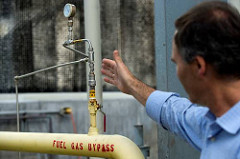Power-to-Gas Tech Can Benefit NatGas Pipelines, Renewable Energy Goals

In a partnership with University of California, Irvine researchers, Southern California Gas Co. earlier this week announced that new research on power-to-gas technology indicates the technique can be used in natural gas pipelines and drastically increase the use of intermittent renewable energy.
“The ability to increase the mix of renewables on campus by tenfold is truly significant,” said Jack Brouwer, associate professor of mechanical & aerospace engineering and civil & environmental engineering at UCI and associate director of the Advanced Power & Energy Program. “With power-to-gas technology, you don’t need to stop renewable power generation when demand is low. Instead, the excess electricity can be used to make hydrogen that can be integrated into existing natural gas pipeline infrastructure and stored for later use. The Southern California Gas Company system alone is made up of over 100,000 miles of pipeline. This study suggests that we could leverage that installed infrastructure for storage and significantly increase the amount of renewable power generation deployed in California.”
Power-to-gas technology takes excess renewable electricity, which would otherwise go to waste, and converts it to hydrogen, which can then be blended with natural gas and used in everything from home appliances to power plants. A five percent blend of hydrogen in SoCalGas’ natural gas system would provide storage capacity equivalent to $130 billion worth of battery systems if purchased at the U.S. Department of Energy future cost of $200 per kilowatt hour. Renewable hydrogen can also be utilized in hydrogen fuel cell vehicles or converted to methane for use in a natural gas pipeline and storage system.
The conversion of renewable electricity to hydrogen enables long-term storage of large amounts of carbon-free power. Scientists say this is a significant advantage over lithium ion batteries, which store energy for shorter time periods and will require extensive construction of battery systems and infrastructure.
The new finding comes from a pilot project funded by SoCalGas and the participation of Proton OnSite, which manufactured the electrolyzer that produces hydrogen from electricity and water. University of California, Irvine engineers and graduate students researched to how beneficial the technology might be and its feasibility for statewide or regional power grids. Power-to-gas systems currently exist in Germany and Canada.
The study used data from the UCI campus microgrid, which includes solar panels that produce about 4 megawatts of peak power. Simulations showed that by storing excess solar power on sunny days and using an electrolyzer to produce renewable hydrogen, the microgrid could support an additional 30 megawatts of solar panels. The increased solar deployment raised the fraction of renewable power used on campus from 3.5 percent to 35 percent.
Related News
Related News

- Keystone Oil Pipeline Resumes Operations After Temporary Shutdown
- Biden Administration Buys Oil for Emergency Reserve Above Target Price
- Freeport LNG Plant Runs Near Zero Consumption for Fifth Day
- Enbridge to Invest $500 Million in Pipeline Assets, Including Expansion of 850-Mile Gray Oak Pipeline
- Williams Delays Louisiana Pipeline Project Amid Dispute with Competitor Energy Transfer
- Evacuation Technologies to Reduce Methane Releases During Pigging
- Editor’s Notebook: Nord Stream’s $20 Billion Question
- Enbridge Receives Approval to Begin Service on Louisiana Venice Gas Pipeline Project
- Mexico Seizes Air Liquide's Hydrogen Plant at Pemex Refinery
- Russian LNG Unfazed By U.S. Sanctions




Comments